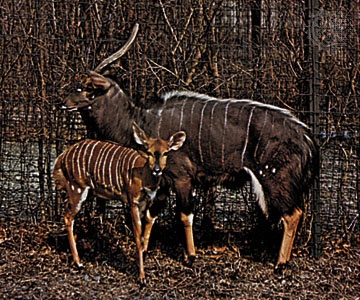nyala
mammal
 slender antelope of southeastern Africa, a member of the spiral-horned antelope tribe Tragelaphini (family Bovidae), which also includes the kudu and eland. The nyala is notable for its extreme gender differences (sexual dimorphism) and specialized habitat preferences that limit its distribution to the Lowveld of southern Africa.
slender antelope of southeastern Africa, a member of the spiral-horned antelope tribe Tragelaphini (family Bovidae), which also includes the kudu and eland. The nyala is notable for its extreme gender differences (sexual dimorphism) and specialized habitat preferences that limit its distribution to the Lowveld of southern Africa.Females and young sport short, bright chestnut coats with 8–13 white stripes on the torso, spots and bands on the legs, chest, and cheeks, and a bushy tail with a white underside. Females weigh about 58 kg (128 pounds) and have a shoulder height of 92 cm (36 inches). Males are much larger, standing 106 cm (42 inches) tall and weighing 98–125 kg (216–275 pounds), and carry horns 60–83 cm (24–33 inches) long with 1.5–2.5 twists. They gradually turn dark charcoal gray and shaggy as they mature and have a long fringe from throat to hindquarters and an erectile spinal crest from head to tail. Their stripes and spots mostly disappear under the long hair, but the tan lower legs, ears, and forehead persist. Males resemble a dryland version of the male sitatunga, whereas females could pass for lesser kudus (kudu).
The nyala is a cover-dependent browser and grazer that occupies the densest woodlands close to water on the coastal plain and in major river valleys of eastern Africa from southern Malawi (Malaŵi) to Natal. The habitat has to include high-quality grassland next to the cover where nyalas spend daytimes and from which they emerge to graze green grass at night during the rainy season. Browse, including the foliage of various dicotyledons (dicotyledon) as well as forbs, seeds, and fruits, dominates the dry-season diet.
Females and young form loose herds of five or six animals with home ranges of 50–100 hectares (120–250 acres). Males are nonterritorial, share overlapping ranges of about 80 hectares (200 acres), associate in fluid bachelor herds as subadults, and compete for dominance with a spectacular lateral display that gives the shaggiest seniors with the longest horns the advantage. Mating peaks occur during the summer in the southernmost populations, but births occur year-round, after a seven-month gestation. Calves lie out for 10–18 days before accompanying and foraging with their mothers.
The related mountain nyala (Tragelaphus buxtoni), endemic to the Ethiopian highlands east of the Rift Valley and discovered only in 1908, is much more like a greater kudu than another nyala in size, proportions, and social organization. Both sexes are gray-brown with faded stripes but have two conspicuous white throat patches, nose chevron, cheek spots, and underside of the bushy tail and a brown-and-white spinal crest. Coat length varies seasonally. Senior males are sepia-coloured, with open spiral horns up to 120 cm (47 inches) along the curve. Males, nearly as big as the greater kudu, stand up to 130 cm (51 inches) and weigh up to 300 kg (660 pounds); females weigh 150–200 kg (330–440 pounds).
Specialized for montane habitats between 3,000 and 4,500 metres (10,000 and 15,000 feet) and having a limited geographic range, the mountain nyala is a particularly vulnerable species. Increasing human population and susceptibility to livestock diseases had already reduced the species to remnant groups outside of Ethiopia's Bale Mountains National Park. There, beginning in the 1970s, they increased to at least 1,700 over 15 years of effective protection. However, after the Ethiopian revolution of 1991, the park was overrun, and the mountain nyala population was reduced to an estimated 150 animals. After protection was restored, the population quickly increased to more than 2,500 by the end of the century. The mountain nyala is now classified as an endangered species.